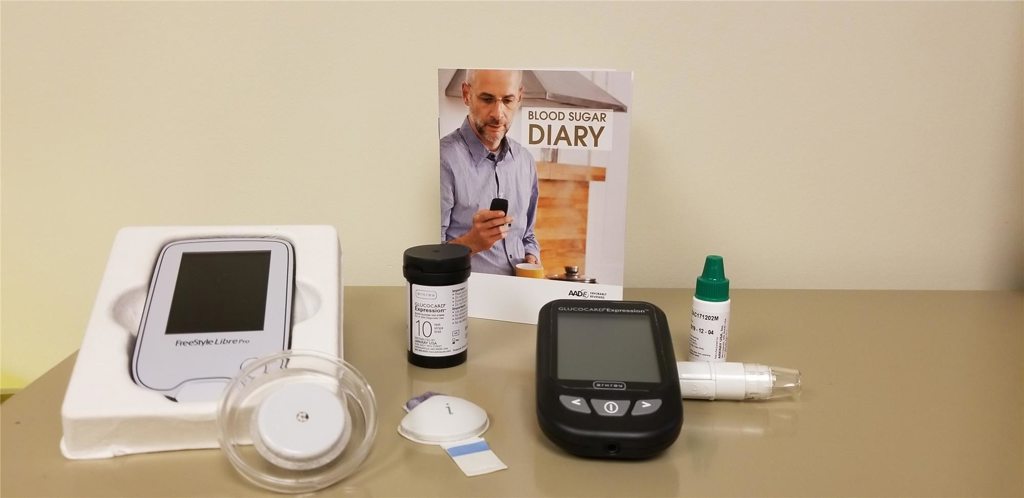
Blood Glucose Monitoring Is Important
PHH Can Provide Free Monitors
November is American Diabetes Month, an important time to raise awareness and understanding of diabetes. Approximately 10 percent of the adults in our region have been diagnosed with diabetes, according to statistics from the Centers for Disease Control for our state counties. Clearfield County is a little higher at 11.6 percent while the surrounding counties range between 7.7 in Cameron County, 8.2 percent in Elk County, 9.3 percent in Jefferson County and 10 percent in Clarion County.
Diabetes is a group of diseases marked by high levels of blood glucose resulting from problems in how insulin, a hormone in the body, is produced, how it works or both. Diabetes is one of the leading causes of disability and death in the United States causing blindness, nerve damage, kidney disease and other health problems if it is not controlled.
The good news is that it is within our power to regulate our glucose or sugar levels. One way to help is to know how much glucose is in our blood at certain times of day.
There are target ranges that persons with diabetes should aim for or their doctor may have his/her target that they would like the patient to use. “Blood sugar can go up related to amounts of food eaten, sleep deprivation, pain and stress, both illness and mental stress,” Jean Sheley, RN, certified diabetes educator at the Diabetes and Nutrition Wellness Center of Penn Highlands DuBois, said. “Blood sugar levels may drop within 30 minutes of taking medication, such as insulin, and your blood sugar rises in response to what you have eaten,” Carole Berger, RN, certified diabetes educator at the Diabetes and Nutrition Wellness Center of PH DuBois, said.
“Anyone who has been diagnosed with diabetes, whether they manage it with diet and exercise, pills or insulin, should monitor their glucose regularly,” Kelly Schreiber-Straub, registered dietitian, licensed dietitian/nutritionist and certified diabetes educator, and clinical nutrition manager at Penn Highlands Elk, said.
There are two ways to do this – using a blood glucose meter or using a continuous glucose monitor.
“The blood glucose meter is also called a blood glucose monitor,” Sheley said. “It is a device that tests the amount of glucose in the blood.” A blood sample is obtained using a lancet device. A person would lance the side of a finger towards the end, press lightly and get a small sample of blood. This sample is applied to a test strip that is inserted into the monitor. “In five seconds, you will have a blood sugar result,” Sheley said. The number is then recorded in a notebook.
Today, many people are using a continuous glucose monitor versus one that checks blood glucose via finger sticks. “You have probably seen the TV commercials with the sensor worn on the back of the arm that uses a reader to scan the result,” Joyce Kulick, registered dietitian, licensed dietitian/nutritionist, certified diabetes educator at the Diabetes and Nutrition Wellness Center at Penn Highlands DuBois said.
Though different continuous devices collect the information in different manners using tiny sensors, the idea is the same. A sensor is placed under the skin of the belly or it can be adhered to the back of the arm. A transmitter on the sensor then sends the information to a wireless-pager-like monitor that is clipped on a belt. The continuous monitor system tracks blood sugar levels day and night. It collects readings automatically every 5-15 minutes.
Both methods are used to help detect trends and patterns that give those with diabetes and their doctors a more complete picture of their diabetes. “We instruct patients the importance of having their blood glucose within daily target ranges to prevent both high and low blood glucose trends and ultimately, maintain good control. Additionally, many patients are instructed to make daily insulin dosing adjustments based on readings. If you’re guessing blood sugar numbers, there is large risk of error that would result in great harm,” said Lori Rancik, RN, diabetes educator at the Diabetes and Nutrition Wellness Center of PH DuBois, said.
Which method is best? “A healthcare provider can recommend a certain meter brand, but ultimately the patient decides, based on insurance coverage, ease of use, special features and personal preference,” Marie Michelini, registered dietitian, licensed dietitian/nutritionist and certified diabetes educator at Penn Highlands Elk said. “Cost is probably the biggest deciding factor for most people.”
“Over the years, many patients with diabetes have told us that they sometimes lack the money to buy healthy food, let alone the diabetes supplies and medications needed to control their blood glucose levels,” Jeril Goss, registered dietitian, licensed dietitian/nutritionist and certified diabetes educator and manager at the Diabetes and Nutrition Wellness Center of PH DuBois, said. Penn Highlands Healthcare can help.
Since 2014, through the 340B program, the Diabetes and Nutrition Wellness Center at Penn Highlands DuBois has provided blood glucose meters and monitoring supplies to patients referred for diabetes education by Penn Highlands Physician Network providers throughout the system.
“Healthcare providers document the number of times the patient is to test each day, and then we provide testing supplies during their diabetes education session at Penn Highlands Clearfield, PH DuBois or the Moshannon Valley Community Medical Building,” Goss said. “For patients who receive diabetes education elsewhere, such as PH Elk, one annual appointment at one of these three locations is required in order to receive the free supplies to meet the 340B requirements.”
Patients are able to return every three months for supplies. An annual diabetes education follow-up appointment is needed to continue to receive supplies.
To make the best use of our 340B funding, Penn Highlands will be switching from the AgaMatrix blood glucose monitoring system to the Glucocard Expression system. On Tuesday, Nov. 20, from 2-6 p.m., everyone is invited to attend a Diabetes Day event at the Central Resource Center, DuBois, on the second floor in Room 204. This event will provide patients, who currently receive AgaMatrix supplies, an opportunity to acquire the new Glucocard Expression meter and supplies.
Current patients who are unable to attend may visit the Diabetes & Nutrition Wellness Center or are interested in the monitoring system can call 814-375-3890.
And as always, if you have questions about how to better manage your diabetes or how to prevent diabetes, talk to your healthcare provider or have him/her refer you to the diabetes educators at Penn Highlands DuBois covering Clearfield, DuBois, Punxsutawney, Brookville and Phillipsburg at 375-3890 and the diabetes educators at Penn Highlands Elk at 788-8517 or 788-8833.

